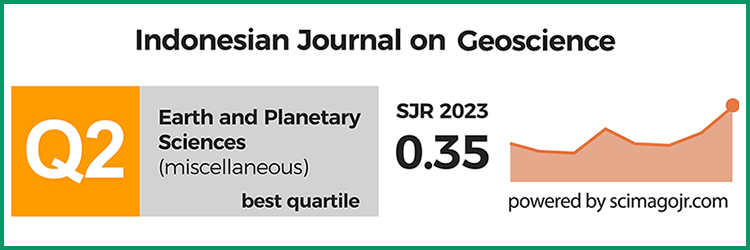Fault-Plane Markings as Displacement Sense Indicators
DOI:
https://doi.org/10.17014/ijog.1.3.151-163Keywords:
fault-plane markings, application in structural analysisAbstract
In order to determine the sense of fault motion, older textbooks advise to stroke the fault surface parallel to its striations, or slickensides. The smoother touch is felt when one’s palm moved in the direction of the adjacent fault surface. Laboratory triaxial tests and abundant field evidence proved this ‘smoothness criterion’ of producing ambiguous results. The first published field evidence contradicting the criterion probably originated from the Lokulo area in Central Jawa over half a century ago. Similar findings from elsewhere around the world have also been printed. A practical nomenclature has since developed. The types of reliable fault-plane markings in various rock types are now known. Recognition of fault-movement sense is essential when outcrop size is limited such as in underground exploration and in trenches. In addition, the present article also shows examples how the sense of faulting is applied to arrive at determining structural evolution of a rock body. The method is readily applied to solve structural problems of more extensive geological terranes.
References
Davis, G.H., 1984, Structural Geology of Rocks and Regions.. Wiley, New York etcetera.
Doblas, M., Mahecha, V., Hoyos, M. & Lopez-Ruiz, J., 1997, Slickenside and fault surface kinematic indicators on active normal faults of the Alpine Betic Cordilleras, Grenada, southern Spain. Journal of Structural Geology 19: 159-170. doi:10.1016/S0191-8141(96)00086-7
Dzulynski, St. & J. Kotlarczyk, 1965, Tectoglyphs on slickensided surfaces. Bulletin de l’Academie Polonaises des Sciences, Serie Geologie et Geographie 17 (2): 149-154.
Norris, D.K. & K. Barron, 1968, Structural analysis of features on natural and artificial faults. Proceedings Conference on Research on Tectonics, National Advisory Committee on Research in the Geological Sciences, Geological Survey of Canada, GSC Paper 68-52: 136-167. Discussions pages 167-74.
Gay, N.C., 1970, The formation of step structures on slickensided shear surfaces. Journal of Geology 78: 523-532.
Paterson, M.S. 1958, Experimental deformation of Wombeyan marble. Bulletin Geological Society of America 69: 465-476. doi:10.1130/0016-7606(1958)69[465:EDAFIW]2.0.CO;2
Petit, J-P., 1976, La zone de decrochements du Tizi n’ Test (Maroc) et son fonctionnement depuis le Carbonifere. These, Universite des Sciences et Techniques du Languedoc: 99 p.
Petit, J-P., 1987, Criteria for the sense of movement on fault surfaces in brittle rocks. Journal of Structural Geology 9: 597-608. doi:10.1016/0191-8141(87)90145-3
Petit, J-P., Proust, F. & Tapponnier, P., 1983, Critere du sens du mouvement sur les mirroirs de failles en roches noncalcaires. Bulletin de la Societe geologique de France 7: 589-608. doi: 10.2113/gssgfbull.S7-XXV.4.589
Riecker, R.F., 1965, Fault-plane features, and alternative explanation. Journal Sedimentary Petrology 35 (3): 746-748. doi:10.1306/74D71339-2B21-11D7-8648000102C1865D
Sander, B., 1970, An Introduction To The Study Of Fabrics Of Geological Bodies. Pergamon, Oxford: 1-631 pages. doi:10.1016/B978-0-08-006660-8.50020-X
Shu, Yeoh Khoon, 1989, The Geology and Mineral Resources of the Kuala Kelawang Area, Jelebu, Negeri Sembilan. Geological Survey of Malaysia, District Memoir 20: 208 pages.
Spray, J.G., 1989, Slickenside formation by surface melting during the mechanical excavation of rock. Journal of Structural Geology 11 (7): 895-905. doi:10.1016/0191-8141(89)90106-5
Tjia, H.D., 1964, Slickensides and fault movements. Bulletin Geological Society of America, 75: 683-686. doi:10.1130/0016-7606(1964)75[683:SAFM]2.0.CO;2
Tjia, H.D., 1966, Structural analysis of the Pre-Tertiary of the Lokulo area, Central Java. Institut Teknologi Bandung, Contributions from the Department of Geology No. 63: 110 p.
Tjia, H.D., 1967, Sense of fault displacements. Geologie en Mijnbouw 48: 392-396.
Tjia, H.D., 1968, Fault-plane markings. XXIII International Geological Congress, Prague, Czechoslovakia 1968, 13: 279-284.
Tjia, H.D., 1972 , Fault movement, reoriented stress field and subsidiary structures. Pacific Geology 5: 49-70.
Wilson, G. 1982, Introduction to Small-scale Geological Structures. George Allen & Unwin, London: Chapter 5. doi:10.1017/S0016756800025383



















